Peavine Creek
Henry Hornbostel Creek
Largely piped underground from Cox Hall to the Peavine Parking Deck, the Henry Hornbostel Creek is one of four named streams on the Druid Hills campus. It is named for Henry Hornbostel, the architect who laid out the original Druid Hills campus master plan.
Antoinette Candler Creek
Lullwater Preserve
Lullwater Preserve is Emory’s largest and most pristine greenspace, serving as a natural recreational space for students, faculty, and other Emory community members to play, exercise, or spend time with friends and family. Purchased from the Candler family in 1962, Lullwater Preserve serves as a testament to Emory’s commitment to environment preservation–throughout the past half century Emory has intervened on multiple occasions when other parties pushed for development of Lullwater. Lullwater boasts environmental diversity, with an impressive spread of native white oaks, poplars, pines, sweet gums, hickories, and beeches. The preservation of this forest has allowed for the re-establishment of large mammals such as the white-tailed deer in the Decatur/Atlanta area, and also serves as an experiment grounds for Emory’s biology and environmental science classes.
Hahn Woods
Hahn Woods was named in 1993 for T. Marshall Hahn Jr., an Emory trustee and then-CEO of Georgia-Pacific. With the help of Georgia-Pacific, Emory reclaimed these 4.7-acres from a landfill. The woods are part of a 60 acre parcel Emory acquired in 1960, which included the Houson Mill House. In 2015 Trees Atlanta instigated a project that focused on restoring the health of Hahn Woods by removing invasive species and replanting native vegetation, particularly in two acres of the woods which serve as a key connection point of the area watershed.
South Fork Peachtree Creek
Biology Research Pond
Hearn Woods Nature Trail/Outdoor Classroom
On the Oxford campus, in 1978, biology professor Curry T. Haynes Sr. carved out a nature trail on the west side of the campus, winding from Williams Gym past the soldiers’ cemetery and into the woods between the cemetery and the dining hall.
Oxhouse Pond & ENVS Center
Protecting all forms of life on campus and implementing programs to actively preserve local ecosystems are cornerstones of Emory’s environmental stewardship.
Department of Environmental Studies
Learn MoreOxford Bamboo Forest
Protecting all forms of life on campus and implementing programs to actively preserve local ecosystems are cornerstones of Emory’s environmental stewardship
Baker Woodlands
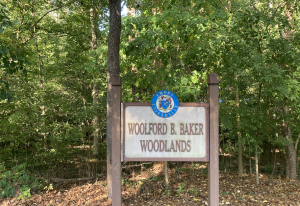
Baker Woodlands, along with the Tull Ravine, is one of the original ravines included in Henry Hornbostel’s vision for Emory’s campus. The ravine is centered around Antoinette Candler Creek, which originates beneath Complex and Harris. This patch of woodland has an incredibly high level of species diversity for its size, and is one of the best places to experience nature on central campus.
American Holly (Ilex opaca)
A native holly, this species is abundant on campus. It is an evergreen shrub to an understory tree with spiny leaves that produces red berries in the fall. Emory’s relationship with the holly began with Antoinette Candler’s cultivation of the Wesley Holly. From there, Biology Professor Woolford Baker began planting a number of different holly cultivars on campus in his capacity as “campus forester.”
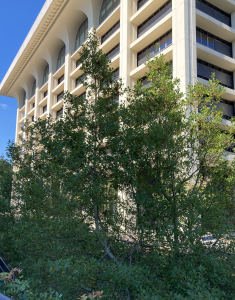
Wesley Holly/East Palatka Holly (Ilex x attenuata)
The East Palatka Holly is a naturally-occurring hybrid between the American holly (Ilex opaca) and the Dahoon holly (Ilex cassine). The Wesley Holly is an individual of the East Palatka Holly which was originally collected by Antoinette Candler. This individual was found growing epiphytically in the crook of the Wesley Oak under which John and Charles Wesley, the founders of Methodism, allegedly preached under. During a pilgrimage to the oak, Antoinette Candler observed this holly and collected it, before planting it on campus. The descendants of the original plant can still be found planted around campus.
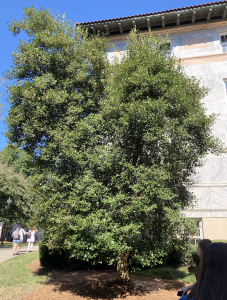
Calhoun Oak/White Oak (Quercus alba)
Oaks are considered keystone organisms due to the fact that numerous wildlife rely on them for food and shelter. The Calhoun Oak, a white oak, was located adjacent to Emory University Hospital, and represents a significant moment in Emory’s environmental history. The tree was slated to be removed in the 1940s, but F. Phinizy Calhoun, a former chair of the Department of Ophthalmology, advocated against its removal. That tree grew to be massive and survived until 2011, when it was removed after becoming infested with ambrosia beetles, a pest that attacks healthy trees. A new (but much smaller) Calhoun oak was planted in its place.
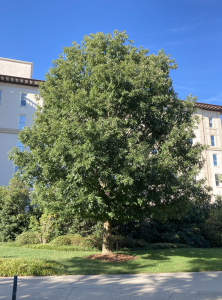
Pecan (Carya illinoiensis)
The pecan trees on the Quad were first planted by Mrs. Warren Candler in the 1920s. A type of hickory, this species is culturally significant to many, and was traded by Indigenous people prior to European colonization. This species is primarily native west of the Mississippi, but has become widespread in Georgia and other parts of the Southeast, where it is cultivated for its fruit. Pecans have weak wood; allegedly during a commencement ceremony, one of the branches from one of these trees fell into the audience. In the time since their planting by Mrs. Warren Candler, these trees have become massive.
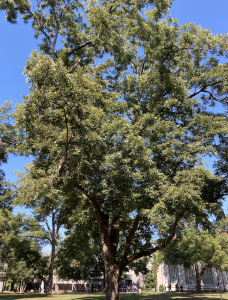
Gingko (Gingko biloba)
Also known as the maidenhair tree, gingko are native to China, where they are consumed and used in traditional medicine. Gingko are a part of an incredibly old lineage of trees and, despite being widely cultivated, is considered endangered in the wild. This species is dioecious, meaning that there are separate male and female plants. Male plants produce motile sperm, similar to mosses and ferns.
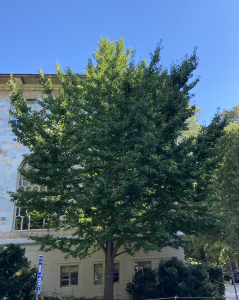
Sugar Maple (Acer saccharum)
The sugar maple is a large hardwood tree prevalent throughout much of the northeast and midwest United States. Shade tolerant, this species is an important forest species throughout many parts of its range. It’s seeds, known as samaras, spin in a helicopter-like pattern when dropped, to the joy of many. Though famous for producing maple syrup, such practices are not common in the south, as we lack the cold winters which induce the plants to store sugar in the same capacity.
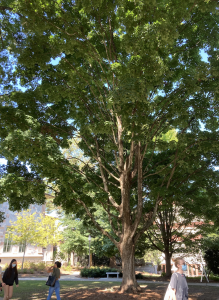
Bottlebrush Buckeye (Aescullus parviflora)
Though typically found in Georgia’s coastal plain rather than the Piedmont, this species is relatively common on campus due to its use in the landscape trade. It can grow as a shrub or understory tree and has palmately compound leaves and long scapes of tiny, white flowers. These plants produce large seeds which are toxic if ingested. This individual is the largest bottlebrush buckeye in Atlanta!
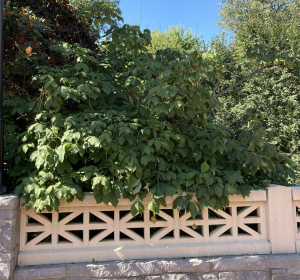
Japanese Magnolia (Magnolia sp.)
This tree is one of two that were gifted to the University, and dates back to the 1920s. While this tree is still standing, its sibling was cut down in order to make space for a cement block. This tree produces many blooms in early spring, but the buds are often killed off by late frost before they have a chance to mature. When the tree manages to nurture its blossoms to maturity, the entire tree is covered in large pink and white flowers.
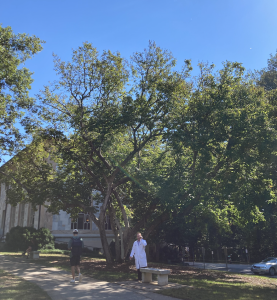
Dawn Redwood (Metasequoia glyptostroboides)
Dawn redwoods are a large conifer native to China which are related to the redwoods of the Pacific Northwest. Very similar in appearance to Georgia’s own bald cypress (Taxodium distichum), this species is another deciduous conifer with feather needles. Fossil records of this species have been dated to 50,000,000 years ago! This species is endangered in its native range.
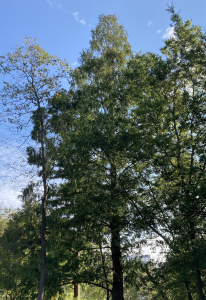
Persimmon (Diospyros virginiana)
Persimmons are unusual and somewhat uncommon trees which have historically been used by Native Americans for their fruit and wood. This species has an unusual and distinctive chunky, dark gray bark. This species serves as a reminder of the biogeographic heritage that the Southeastern United States shares with East Asia, and produces ball-like fruits in the fall.
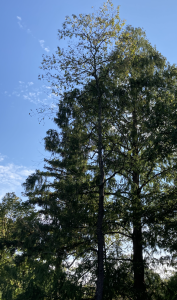
Bald Cypress (Taxodium distichum)
The bald cypress is a deciduous conifer native to the southeastern United States, though is typically found in the coastal plain, rather than the Piedmont. Large cypress forests used to dominate much of the southeast, but many have been logged, leading to a decline in unique, cypress-dominated wetlands.
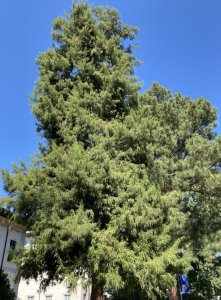
Sterk Elm, American Elm (Ulmus americana)
Large American elms were once widespread throughout the United States, but after the introduction of Dutch Elm Disease to the US, large specimens experienced dramatic declines. In the wild, the species primarily survives through younger individuals which succumb to the disease before they are able to reach their full potentials, but a great amount of work has been put into breeding resistant cultivars. The American elm planted on the Quad is one of such disease resistant individuals, and was planted in 2017 as a part of the inauguration of President Claire Sterk, Emory’s first female president.
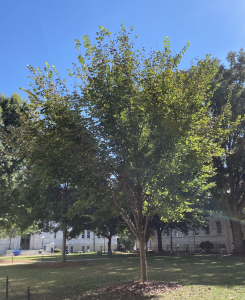
White ash (Fraxinus americana)
This species is at high risk for “contracting” emerald ash borers (Agrilus planipennis), which have all but led to the eradication of large ash trees throughout much of the northern US. There is evidence to suggest that the pest has begun to attack ash trees on campus. Including it in the specimen tree tour would be a good opportunity to raise awareness for the threats facing this species both globally and elsewhere in Emory’s forests. Notice that this specimen has a forked trunk. Near the fork in the trunk, there may be some green or dry gray-looking growths–these are the fronds of the resurrection fern (Pleopeltis michauxiana), a native epiphyte that commonly grows affixed to the bark of ash trees.
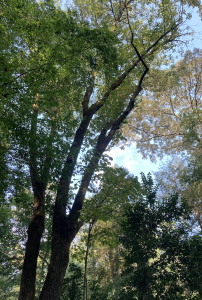
Eastern hemlock (Tsuga canadensis)
The eastern hemlock is an evergreen conifer typically found throughout much of the eastern United States. However, this species has recently faced declines due to the emergence of the hemlock wooly adelgid (Adelges tsugae), an introduced insect pest. This species is ecologically significant, as its evergreen foliage provides year-long shade along ravines, creating a microclimate that is favorable for Rhododendron sp.
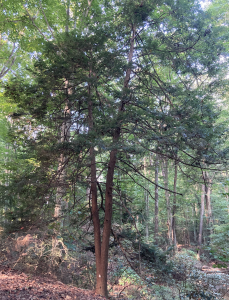
White Mulberry (Morus alba)
The white mulberry is originally native to Asia, and was introduced to North America in order to support a potential trade in silk, as the leaves of this tree are the preferred food source of silkworms. While silkworms did not thrive in the US, the white mulberry did, and escaped cultivation, becoming widespread in many parts of the country. This tree produces small, blackberry-sized fruits in early summer.
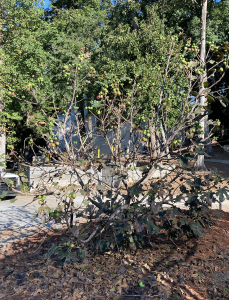
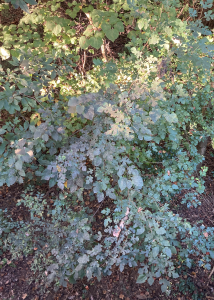
Turkey fig (Ficus carica)
The Turkey fig is a large shrub to small tree native to the Mediterranean and Western Asia. This species thrives in hot, dry areas, and produces edible fruit in late summer to early fall. Traditionally, this species must be pollinated by fig wasps, which become trapped inside of the fruit and are dissolved by enzymes, but cultivated varieties are often able to produce fruit without fertilization by these wasps. 
Serviceberry (Amelanchier arborea)
Also known as juneberries, serviceberries can range in size from a shrub to an understory tree, and are native to North America. In the summer, the tree produces small, blueberry-like fruits. These fruits are popular with both wildlife and humans, and have historically been used by Indigenous peoples for use in making bread.
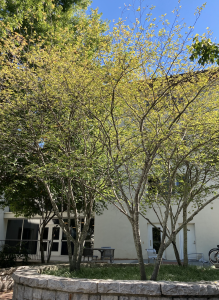
Mathematics and Science Center
Completed in 2002, the Mathematics & Science Center is LEED certified. The Mathematics & Science Center utilizes a closed-loop water cooling system that reduces water use by 69 percent per year, It also has seven showers for use by bicycle commuters, along with recycling stations on every floor and waterless urinals in some men’s bathrooms. The Mathematics & Science Center is also home to Emory’s first green roof.
LEED / Earthcraft Certified
Atwood Chemistry Center Addition
The Atwood Chemistry addition was completed in 2015 after nearly 2 years of construction. It received LEED Gold Certification due to its many sustainability features and green building practices.
LEED / Earthcraft Certified
Psychology and Interdisciplinary Sciences Building
The Psychology and Interdisciplinary Sciences (PAIS) Building is Gold LEED Certified. The structure’s exterior design includes bioswale in the courtyard, diminishing storm water runoff. The wood-based building materials are harvested from FSC-certified forests and the design makes ample use of natural light.
LEED / Earthcraft Certified
Rita Anne Rollins Building, Candler School of Theology
the Rita Anne Rollins building of the Candler School of Theology was completed in 2008 and received LEED silver certification in 2010. This project is unique in that the pavers used in the hardscape surrounding the building are made of a high-emittance material that lowers the site’s overall heat-island effect. The site was also the former location of buried steam pipes that were insulated with asbestos, and their remediation before the building was constructed allowed the project to earn the ‘brownfield redevelopment’ credit.
LEED / Earthcraft certified
Candler Library
Candler Library Renovation and Expansion attained the 1st SILVER LEED certification on campus for a renovation project.
LEED / Earthcraft Certified
Goizueta Business School
In 2005, Emory’s Goizueta Business School became the first Gold certified LEED for Existing Buildings in the count
LEED / Earthcraft Certified
Goizueta Foundation Center
The Goizueta Foundation Center is LEED Gold Certified. As one of the most energy efficient buildings on campus, the GFC’s low flow fixtures reduce water usage by 20 percent, and energy use by 36 percent. An underground cistern captures storm water and condensate from the air handling unit, and that water is reused for irrigation of campus plantings.
LEED / Earthcraft Certified
Emory Children's Center
The Emory Children’s Center Building is a clinical building jointly owned by Emory and Children’s Healthcare of Atlanta. It is LEED Certified.
Health Sciences Research Building
The new Health Sciences Research Building was completed in 2013 following the demolition of the Turman West Residence Hall, and was designed to achieve LEED Silver Certification due to its unique green features such as sensors which control the heating system based on number of persons in the building. Emory utilized many green practices in the construction of this building, as 18,548 tons of waste were recycled during construction, or 98% of all construction waste.
LEED / Earthcraft Certified
James B Williams School of Medicine Building
Completed in 2007, The School of Medicine’s James B. Williams Medical Education Building is Silver LEED certified.
Alabama Residence Hall
Renovated in the summers of 2013 and 2014, the Alabama Hall Renovation kept with Emory’s Sustainability Goals and achieved LEED Gold Certification for the many green processes incorporated into its construction, as well as the green design of the building.
LEED / Earthcraft Certified
Turman Residence Hall
Turman Hall was the first LEED Silver certified residence hall in the state of Georgia. Opened in 2007, Turman was the first residence hall on campus to include green features such as dual-flush toilets, low-flow faucets, and flooring made from recycled materials such as automobile glass.
LEED / Earthcraft Certified
Hamilton Holmes Residence Hall
This phase of Emory’s first year housing was completed in the summer of 2012 and received LEED Gold Certification. The five-story residence hall features many green aspects in its design and infrastructure, such as graywater in flush toilets and bamboo flooring.
LEED / Earthcraft Certified
Few & Evans Residence Halls
Evans and Few Halls are Emory’s sixth and seventh buildings to receive LEED Gold certification. Completed in 2008, Evans and Few Halls incorporated many sustainable building design technologies that were innovative at the time. Solar power is used to pump rainwater from a cistern into dual-flush toilets, motion sensors are in individual student rooms and public areas, energy efficient heating and cooling systems are included throughout the complex, the flooring materials in the residence halls are made from recycled carpet, bamboo or recycled automobile glass, and there is a bicycle storage room for over 40 bikes.
LEED / Earthcraft Certified
Emory University Hospital Tower
Completed in 2017, Emory University Hospital Tower is the first Emory Healthcare building to become LEED certified.
Emory Conference Center Hotel
Following renovation in 2010, the Emory Conference Center Hotel achieved LEED Silver status for its environmentally friendly practices such as access to alternative transportation, water efficiency, the recycling and reuse of building materials and resources, indoor environmental air quality, and innovation in design.
LEED / Earthcraft Certified
Emory National Primate Research Center Dual Function Facility
Construction on Yerkes Dual Function Research Facility was completed in March 2013 and the building received LEED Gold Certification shortly after its completion.
LEED / Earthcraft Certified
Emory National Primate Research Center Integrated Research Addition
Emory’s expansion of the Yerkes Neurosciences Research Building was completed in March 2013 and received LEED Silver Certification for its green design and integrated infrastructure.
Claudia Nance Rollins Building
The Claudia Nance Rollins Public Health Building is Silver LEED Certified. The 8 story building opened in 2010 and was constucted using recycled and renewable materials. The building also includes carbon dioxide monitors, high-efficiency lighting and an enthalpy wheel, which is used to minimize energy use.
LEED / Earthcraft Certified
Whitehead Biomedical Research Building
In 2002, Whitehead Medical Research Building became the first LEED certified building constructed in the Southeast. It currently has Silver LEED certification.
LEED / Earthcraft Certified
Eleanore Raoul Residence Hall
Eleanore Raoul residence hall opened in 2014 and is certified LEED Gold. It was the first on Emory’s campus to use LED lighting from inception. Water reclaimed and cleaned in the Water Hub is used in the toilets in order to limit Emory’s stress on local watersheds.
LEED / Earthcraft Certified
Emory Student Center
Completed in 2019, the Emory Student Center is the first Emory building to become LEED Platinum certified. The Student Center employs 400-foot-deep geothermal wells dug into nearby McDonough Field to help heat and cool the facility, and several of the exterior glass walls boast solar-tracking shades to block the heat of the day.
LEED / Earthcraft Certified
Eagle Hall
Opened in 2010, Eagle Hall is Gold LEED Certified. It features several green amenities, including room occupancy sensor lights, low-flow shower and sink faucets, and dual-flush toilets that are flushed using recycled rain water.
LEED / Earthcraft Certified
Pitts Theology Library
Completed in August 2014, this addition to the Candler School of Theology was built with the intention of receiving LEED Silver Certification and received this certification shortly after its completion.
LEED / Earthcraft Certified
Green Roof at Complex Residence Ha
The green roof in Complex Freshman Residential Center sits between Hopkins and Smith halls, and was established in 2015 through an OSI Sustainability Incentives Fund grant. In addition to drought-tolerant plants and native species, this green roof boasts lights, outdoor furniture, water fountains, and electrical outlets. The goal was to design a green space that improved energy efficiency and also cultivated a space for students to study or spend leisure time. Emory works to encourage connections between nature and its community in its cultivation of its green spaces, and this green roof serves as just one example of Emory’s commitment to forging environmental relationships.
Green Roof at Facilities & Maintenance Building B
The green roof installed along the walkway by Facilities & Maintenance Building B was one of the first installed on Emory’s campus. This green roof serves as an experimental demonstration plot, with slightly different types of bedding and soils in each planting tray in order for students to make scientific comparisons.
Green Roof on Eagle Hall
Longstreet-Means Freshman Residential Hall, which opened in the Fall of 2010, incorporated many green aspects into its design in order to achieve its LEED Gold Certification. One of these green features was a miniature green roof, which lines the windows on the Eastern wall of the third floor. On the other side of the building, another narrow bed of plants have also found a home on a different roof outcropping. The majority of the plants here were not artificially planted, but instead native species, whose spores and seeds landed on these patches of soil.
Green Roof on Mathematics & Sciences Center
The first green roof on Emory’s campus, the green garden topping the Mathematics & Science Center was originally installed in October 2008. The project was part of a student-led pilot study exploring the benefits of green roofs, but in the past decade had fallen into disrepair. The green roof was revived in 2016 by former Emory student Rebecca Park, who had a particular interest in green infrastructure. The MSC green roof now boasts more than 500 native plants–primarily specimens of drought-tolerant sedum and delosperma–and is cared for by students in the environmental sciences department.
Green Roof on James W. Wagner Quadrangle
The James W. Wagner Quadrangle, a green space among the residence halls of the Freshman Village, is a vegetated green roof for the partking deck below.
Green Roof on Rollins Research Center & Rollins School of Public Health
Science Building
Constructing healthy and highly-efficient buildings and renovating existing ones to green building standards are cornerstones of Emory’s sustainability commitments.
Language Hall Addition
Constructing healthy and highly-efficient buildings and renovating existing ones to green building standards are cornerstones of Emory’s sustainability commitments.
Emory Musculoskeletal Center
In fall 2021, Emory unveiled a new Musculoskeletal Center as a part of Emory Healthcare. This building will serve patients with orthopaedic and musculoskeletal needs, and has also incorporated numerous sustainability features into its construction. This building is pending LEED Gold certification.
Sustainability Features
- strategic lighting for energy saving and light pollution reduction
- bioswales and other green infrastructure to control the discharge of stormwater runoff into the watershed
- automatically-tinting windows to control the amount of light entering the building and reduce heating costs
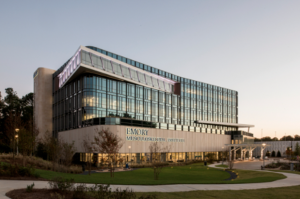
Convocation Hall
Constructed in 1909 as the Theology School’s chapel, Convocation Hall now houses the President’s office and other spaces for Emory administrators. As a part of renovations on this building, a number of sustainability features were incorporated into its new design, earning it LEED Gold status; it is Emory’s first building to do so under LEED version 4.
Sustainability Features:
- installation of more energy-efficient windows
- improved insulation in the attic area
- use of WaterHub’s reclaimed water via central plant cooling towers
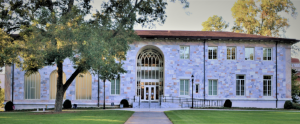
Oxford Student Center
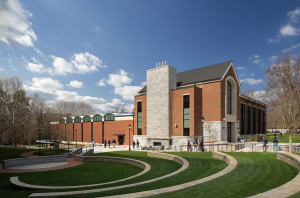
The LEED-Silver Oxford College Student Center consists of the renovation of the existing circa 1967 Dining Hall (~20,000 sf), a two-level addition to be constructed on the east side of the Dining Hall (~12,000 sf), and site improvements around both integrating the project into a network of existing pedestrian paths, plazas, roads and sidewalks that seamlessly incorporate into the existing campus.
Selected Sustainability Features
- Low emissivity materials for roof and site paving reduces heat island effect
- Use of water for irrigation is reduced by 60%
- Reduced energy consumption in both electricity & natural gas via enhanced energy performance will result in reduced building annual carbon emissions of ~109 mtCO2e (metric tons CO2 equivalent)
- ~87% of construction waste (~621 tons) was recycled/diverted from landfill
Solar PV on Lowergate South Parking Deck
Future site of solar panel installation as part of the Solar Energy Procurement Agreement (SEPA) with Cherry Street Energy!
Solar PV on Health Sciences Research Building I rooftop
In December 2020, solar panels were installed on the Health Sciences Research Building I in the initial phase of the Emory-Cherry Street Energy Solar Energy Procurement Agreement (SEPA) project.
Solar PV Gambrell School of Law Rooftop
In November 2020, 83kw of rooftop solar was installed on the Gambrell School of Law building rooftop and parking deck top floor in the initial phase of the Emory-Cherry Street Energy Solar Energy Procurement Agreement (SEPA) project.
Solar PV on 1599 Clifton Road Building Rooftop
In August 2020, 83kw of rooftop solar was installed on the 1599 Clifton Road building rooftop and parking deck top floor in the initial phase of the Emory-Cherry Street Energy Solar Energy Procurement Agreement (SEPA) project.
Solar PV on Peavine South Parking Deck Canopy
In Spring 2021, solar panels were installed on the Peavine South Parking Deck in the initial phase of the Emory-Cherry Street Energy Solar Energy Procurement Agreement (SEPA) project.
Solar PV on Peavine North Parking Deck Canopy
In Spring 2021, solar panels were installed on the Peavine North Parking Deck in the initial phase of the Emory-Cherry Street Energy Solar Energy Procurement Agreement (SEPA) project.
Solar PV on Fishburne Parking Deck Canopy
In June 2021, solar panels were installed on the Fishburne Parking Deck in the initial phase of the Emory-Cherry Street Energy Solar Energy Procurement Agreement (SEPA) project.
Solar PV on Emory Conference Center Hotel Parking Deck
In Fall 2020, solar panels were installed on the Emory Conference Center Hotel Parking Deck in the initial phase of the Emory-Cherry Street Energy Solar Energy Procurement Agreement (SEPA) project.
Solar PV on Clairmont Starvine Parking Deck
Future site of solar panel installation as part of the Solar Energy Procurement Agreement (SEPA) with Cherry Street Energy!
Solar PV on 1599 Clifton Road Parking Deck Canopy
In Fall 2020, solar panels were installed on the 1599 Clifton Road Parking Deck Canopy in the initial phase of the Emory-Cherry Street Energy Solar Energy Procurement Agreement (SEPA) project.
Co-generation or Combined Heat and Power
A steam-turbine generator at Emory’s steam plant produces one megawatt of clean power for the campus. Emory’s steam plant burns natural gas to create pressurized steam. Cogeneration/CHP recovers mechanical heat produced by turning generators, adds that heat to the steam system and is able to generate even more electricity by spinning the steam turbine under higher pressures. Link: https://sustainability.emory.edu/emory-university-adds-1mw-of-clean-power-with-innovative-cogeneration-combined-heat-and-power-system/
Solar PV at the WaterHub
Emory’s WaterHub is the first water reclamation facility of its kind in the nation. The solar panels adjacent to the facility provide a portion of the energy required to run the facility, and serve as a demonstration of solar technology on the ground, making solar panels more visible for students and visible than those on Emory’s rooftops.
Solar PV on North Decatur Building Rooftop
Emory installed its first rooftop solar panels in the summer of 2015 through participation in Georgia Power’s Advanced Solar Initiative. The North Decatur Building rooftop panels were installed at the same time as the 1762 Clifton Road rooftop panels, which together generate 265 kWh of energy. Solar is one strategy for achieving Emory’s goals of 45% GHG emissions reductions by 2030, and carbon neutrality by 2050.
Geothermal Energy at McDonough Field
A system of 400-foot deep geothermal wells dug into McDonough Field provide some 700 tons of heating/cooling capacity to the Emory Student Center.
Solar PV on 1762 Clifton Rd Rooftop
Emory installed its first rooftop solar panels in the summer of 2015 through participation in Georgia Power’s Advanced Solar Initiative. The 1762 Clifton Road rooftop panels were installed at the same time as the North Decatur rooftop panels, which together generate 265 kWh of energy. Solar is one strategy for achieving Emory’s goals of 45% GHG emissions reductions by 2030, and carbon neutrality by 2050.
Solar Water Heating at Emory Student Center
A solar water heating system located in the rectangular panels on the roof of the North Pavilion provides about 40 percent of the building’s hot water needs.
Solar PV on Lowergate East Parking Deck
Future site of solar panel installation as part of the Solar Energy Procurement Agreement (SEPA) with Cherry Street Energy!
Solar PV on EmTech Library Service Center Rooftop
In June 2022, solar panels were installed on the Library Services Center in the initial phase of the Emory-Cherry Street Energy Solar Energy Procurement Agreement (SEPA) project.
The EmTech Library Service Center, created in collaboration between Emory University and the Georgia Institute of Technology, opened its doors in March 2016. The Library Service Center was built to house a shared collection amassing millions of books and other materials , with the goal of making these materials seamlessly available to faculty, staff, and students at both Emory and Georgia Tech. This joint project marks the latest chapter in a longstanding public-private partnership between the Atlanta-based institutions and offers advantages for both universities. The solar panels on this building help mitigate the building’s energy use while advancing both universities’ missions of increased sustainability and environmental awareness.
Solar PV on Clairmont Starvine Parking Deck
Future site of solar panel installation as part of the Solar Energy Procurement Agreement (SEPA) with Cherry Street Energy!
Solar PV on Lowergate South Parking Deck
Future site of solar panel installation as part of the Solar Energy Procurement Agreement (SEPA) with Cherry Street Energy!
Solar PV on Health Sciences Research Building I Rooftop
In December 2020, solar panels were installed on the Health Sciences Research Building I in the initial phase of the Emory-Cherry Street Energy Solar Energy Procurement Agreement (SEPA) project.
Solar PV Gambrell School of Law Rooftop
In November 2020, 83kw of rooftop solar was installed on the Gambrell School of Law building rooftop and parking deck top floor in the initial phase of the Emory-Cherry Street Energy Solar Energy Procurement Agreement (SEPA) project.
Solar PV on 1599 Clifton Road Building Rooftop
In August 2020, 83kw of rooftop solar was installed on the 1599 Clifton Road building rooftop and parking deck top floor in the initial phase of the Emory-Cherry Street Energy Solar Energy Procurement Agreement (SEPA) project.
Solar PV on Peavine South Parking Deck
In Spring 2021, solar panels were installed on the Peavine South Parking Deck in the initial phase of the Emory-Cherry Street Energy Solar Energy Procurement Agreement (SEPA) project.
Solar PV on Peavine North Parking Deck
In Spring 2021, solar panels were installed on the Peavine North Parking Deck in the initial phase of the Emory-Cherry Street Energy Solar Energy Procurement Agreement (SEPA) project.
Solar PV on Fishburne Parking Deck
In June 2021, solar panels were installed on the Fishburne Parking Deck in the initial phase of the Emory-Cherry Street Energy Solar Energy Procurement Agreement (SEPA) project.
Solar PV on Emory Conference Center Hotel Parking Deck
In Fall 2020, solar panels were installed on the Emory Conference Center Hotel Parking Deck in the initial phase of the Emory-Cherry Street Energy Solar Energy Procurement Agreement (SEPA) project.
Solar PV on Clairmont Starvine Parking Deck
Future site of solar panel installation as part of the Solar Energy Procurement Agreement (SEPA) with Cherry Street Energy!
Solar PV on 1599 Clifton Road Parking Deck Canopy
In Fall 2020, solar panels were installed on the 1599 Clifton Road Parking Deck Canopy in the initial phase of the Emory-Cherry Street Energy Solar Energy Procurement Agreement (SEPA) project.
Co-generation or Combined Heat and Power
A steam-turbine generator at Emory’s steam plant produces one megawatt of clean power for the campus. Emory’s steam plant burns natural gas to create pressurized steam. Cogeneration/CHP recovers mechanical heat produced by turning generators, adds that heat to the steam system and is able to generate even more electricity by spinning the steam turbine under higher pressures. Link: https://sustainability.emory.edu/emory-university-adds-1mw-of-clean-power-with-innovative-cogeneration-combined-heat-and-power-system/
Geothermal Energy at McDonough Field
A system of 400-foot deep geothermal wells dug into McDonough Field provide some 700 tons of heating/cooling capacity to the Emory Student Center.
Solar PV on 1762 Clifton Rd Rooftop
Emory installed its first rooftop solar panels in the summer of 2015 through participation in Georgia Power’s Advanced Solar Initiative. The 1762 Clifton Road rooftop panels were installed at the same time as the North Decatur rooftop panels, which together generate 265 kWh of energy. Solar is one strategy for achieving Emory’s goals of 45% GHG emissions reductions by 2030, and carbon neutrality by 2050.
Solar Water Heating at Emory Student Center
A solar water heating system located in the rectangular panels on the roof of the North Pavilion provides about 40 percent of the building’s hot water needs.
Solar PV at the WaterHub
Solar PV on North Decatur Building Rooftop
Emory installed its first rooftop solar panels in the summer of 2015 through participation in Georgia Power’s Advanced Solar Initiative. The North Decatur Building rooftop panels were installed at the same time as the 1762 Clifton Road rooftop panels, which together generate 265 kWh of energy. Solar is one strategy for achieving Emory’s goals of 45% GHG emissions reductions by 2030, and carbon neutrality by 2050.
Cox Hall Solar Power Charging Station
Cox Hall serves as a major dining hall, study center, and recreational space for Emory students and staff alike, and–as of summer 2015–boasts two solar-powered charging stations as well. Students can charge up to three electronic devices at a time at these solar-powered charging stations using a USB plug-in. These stations serve to bring renewable energy awareness to Emory students and thus cultivate a more environmentally conscious atmosphere on campus.
Law School Solar Charging Station
Emory’s Law School houses solar-powered charging stations students, staff and faculty are able use to charge their electronic devices via USB plug-in at these stations located in the courtyard. These stations help reduce Emory’s consumption of nonrenewable energy and signifies Emory’s commitment to sustainability in all of its schools and campuses.
ChargePoint Charging Station
Another solar-powered charging station has been installed on Emory’s Oxford campus, allowing Oxford students to utilize renewable energy in order to recharge their electronic devices.
Solar PV on EmTech Library Service Center Rooftop
In June 2022, solar panels were installed on the Library Services Center in the initial phase of the Emory-Cherry Street Energy Solar Energy Procurement Agreement (SEPA) project.
The EmTech Library Service Center, created in collaboration between Emory University and the Georgia Institute of Technology, opened its doors in March 2016. The Library Service Center was built to house a shared collection amassing millions of books and other materials , with the goal of making these materials seamlessly available to faculty, staff, and students at both Emory and Georgia Tech. This joint project marks the latest chapter in a longstanding public-private partnership between the Atlanta-based institutions and offers advantages for both universities. The solar panels on this building help mitigate the building’s energy use while advancing both universities’ missions of increased sustainability and environmental awareness.
Solar PV on Lowergate East Parking Deck
Future site of solar panel installation as part of the Solar Energy Procurement Agreement (SEPA) with Cherry Street Energy!
Candler School of Theology Garden
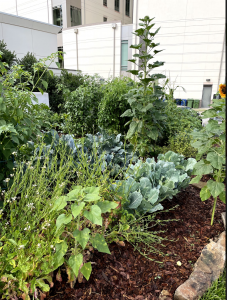
The Theology garden is the largest of the Educational Gardens on campus, and was first created in partnership between the Candler School of Theology and Department of Physics.
The gardens are maintained by teams of volunteers that meet for weekly workdays. Most gardens are led by undergraduate and graduate student groups, departments, or classes, but all members of the Emory community are welcome to volunteer. No prior experience is needed.
Clairmont Campus Garden

The Clairmont Garden was started by an Emory Faculty-in-Residence, Levin Arnsperger, who saw the opportunity to expand the Garden Project to the campus. He secured an OSI General Sustainability & Social Justice Incentives Fund grant and the support of Residence Life to make the garden a reality.
The gardens are maintained by teams of volunteers that meet for weekly workdays. Most gardens are led by undergraduate and graduate student groups, departments, or classes, but all members of the Emory community are welcome to volunteer. No prior experience is needed.
Cox Hall Garden
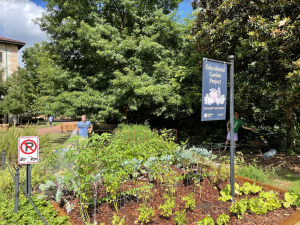
The gardens are maintained by teams of volunteers that meet for weekly workdays. Most gardens are led by undergraduate and graduate student groups, departments, or classes, but all members of the Emory community are welcome to volunteer. No prior experience is needed.
Depot Garden
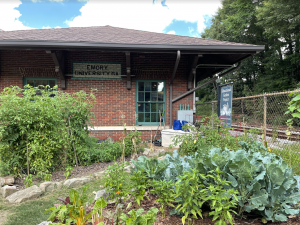
The gardens are maintained by teams of volunteers that meet for weekly workdays. Most gardens are led by undergraduate and graduate student groups, departments, or classes, but all members of the Emory community are welcome to volunteer. No prior experience is needed.
James B. Williams School of Medicine Garden
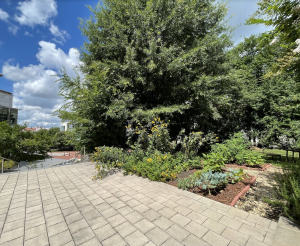
The gardens are maintained by teams of volunteers that meet for weekly workdays. Most gardens are led by undergraduate and graduate student groups, departments, or classes, but all members of the Emory community are welcome to volunteer. No prior experience is needed.
Nell Hogdson Woodruff School of Nursing Garden
The gardens are maintained by teams of volunteers that meet for weekly workdays. Most gardens are led by undergraduate and graduate student groups, departments, or classes, but all members of the Emory community are welcome to volunteer. No prior experience is needed.
Rollins School of Public Health Garden
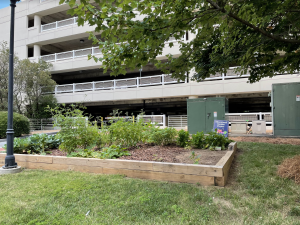
The gardens are maintained by teams of volunteers that meet for weekly workdays. Most gardens are led by undergraduate and graduate student groups, departments, or classes, but all members of the Emory community are welcome to volunteer. No prior experience is needed.
WoodPEC Garden
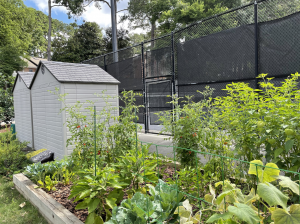
The gardens are maintained by teams of volunteers that meet for weekly workdays. Most gardens are led by undergraduate and graduate student groups, departments, or classes, but all members of the Emory community are welcome to volunteer. No prior experience is needed.
Emory Farmers Market
Since 2008, the Emory Farmers Market has been a lively campus community space for local farms and businesses that offer a wide selection of fresh produce, hand-crafted goods, and diverse beverage and lunch options for students, faculty, and staff.
Currently, the market will be held on Tuesdays from 11-2 on McDonough Plaza, the greenspace between the WoodPEC and the Emory Student Center.
Few Demonstration Kitchen
The Few Hall Demo Kitchen can be reserved through the 25 Live system for cooking demonstrations and food recovery student group events, as well as for courses taught about and through cooking. Reservations are managed by Emory Dining.
Oxford Organic Farm
The 11-acre piece of land that this farm rests on was given to Oxford by an alumnus in 2011. Oxford decided to create a working organic farm on this land that not only provided fresh produce for student dining, but also provided hands-on interdisciplinary learning experiences for students. Many Oxford faculty members in all fields, including sociology, biology, philosophy, environmental science, and wellness, incorporate Oxford farm into their curricula.
Kaldi’s Coffee Shop at Emory University
Pick-up location for Oxford Farm CSA: from 12pm until Kaldi’s closes.
Are you looking for local, organically-grown food? Delicious varieties harvested at the peak of ripeness? Then you should join the Oxford College Farm Community Supported Agriculture Program! Located on the edge of Oxford campus, the Emory Oxford Organic Farm was created in 2014 after the donation of eleven acres of land from an Emory alumnus. Organic, fresh food is grown both for Emory’s campuses and the surrounding community.
Math Sciences Building
Pick-up location for Oxford Farm CSA: Math Sciences Building from 12pm – 4:30pm.
Are you looking for local, organically-grown food? Delicious varieties harvested at the peak of ripeness? Then you should join the Oxford College Farm Community Supported Agriculture Program! Located on the edge of Oxford campus, the Emory Oxford Organic Farm was created in 2014 after the donation of eleven acres of land from an Emory alumnus. Organic, fresh food is grown both for Emory’s campuses and the surrounding community.
Emory University Hospital
Pick-up location for Oxford Farm CSA: Emory hospital behind Coffee Central near the main lobby on the 2nd floor from 11am – 6pm.
Are you looking for local, organically-grown food? Delicious varieties harvested at the peak of ripeness? Then you should join the Oxford College Farm Community Supported Agriculture Program! Located on the edge of Oxford campus, the Emory Oxford Organic Farm was created in 2014 after the donation of eleven acres of land from an Emory alumnus. Organic, fresh food is grown both for Emory’s campuses and the surrounding community.
Emory Midtown Hospital
Emory Musculoskelatal Center
Cox Hall
In March of 1969, Emory’s Black Student Alliance presented a series of demands to President Atwood regarding racial injustices they felt were still prevalent on Emory’s campus. By May, the administration had made little progress on meeting their demands, so the BSA staged one of the most significant student activist protests in Emory’s history. On Sunday, they marched from the Pitts Theology Building, then Emory’s main chapel, to Cox Hall, holding up printed signs at the doors and lunch lines and handing out statements that detailed their complaints about how the university treated black employees. On Monday, the BSA held an enthusiastically attended rally on the Quad, drawing 500 students to hear their documentation of racist actions and policies at Emory. Ultimately, the activism of the BSA catalyzed major changes to the university, including the creation of the African-American Studies program and the hiring of the first African-American administrator.
1599 Clifton Road Parking Deck
Enterprise CarShare is a car share program that a convenient and flexible method of transportation for the Emory community.
1599 Clifton Road Parking Deck
Enterprise CarShare is a car share program that a convenient and flexible method of transportation for the Emory community.
1762 Clifton Road Parking Deck
Enterprise CarShare is a car share program that a convenient and flexible method of transportation for the Emory community.
Michael Street Parking Deck
Enterprise CarShare is a car share program that a convenient and flexible method of transportation for the Emory community.
Boisfeuillet Jones Center Parking Deck (Clairmont Tower)
In 2019, Emory’s Transportation and Parking Services installed a new electric vehicle charging station on main campus. Since its installation, the unit has contributed to a 17% increase in GHG emissions savings.
Open to all electric vehicles 24 hours a day.
Emory Clinic Parking Deck
Transport accounts for roughly 14 percent of all greenhouse gas emissions. As transport is a function of economic growth, the city of Atlanta and Emory are committed to reducing emissions through investment in and implementation of sustainable transportation solutions.
Lowergate South Parking Deck
In 2019, Emory’s Transportation and Parking Services installed a new electric vehicle charging station on main campus. Since its installation, the unit has contributed to a 17% increase in GHG emissions savings.
Peavine Deck EV Charging Station
The Peavine II parking deck has 4 spaces for charging electric vehicles (EV).
Open to Emory permit holders 24 hours a day. Open to all cars after 4:00 p.m., Monday through Friday.
Clairmont Campus Parking Deck
Enterprise CarShare is an automated way to rent a vehicle by the hour, the day, or overnight. A variety of makes and models are parked in your community – where you live, and where you work – and are accessible 24/7.
Oxford Road Express Charger
One space. Open to to all electric vehicles 24 hours per day.
WOODRUFF Residential
Woodruff Lobby – 1st Floor
Additional glass recycling bin at the loading dock.
COMPLEX HALL
Hopkins Hall Lobby facing Goizueta Business School. Closest station to Smith, Thomas, and Harris.
Additional glass recycling bin outside the back door of Harris Hall.
KALDI'S
Glass recycling bin next to the Depot by Kaldi’s Coffee
DOBBS HALL
Glass recycling bin outside of the south side of the building by the back door
ALABAMA HALL
Glass recycling bin by Service Vehicle Parking Spot
EAGLE HALL
Glass recycling bin in the Raoul Parking Deck
FRATS 6-12
Glass recycling bin behind House 10 by the tennis courts
FRATS 14-22
Glass recycling bin behind house 14 and 18.
FRAT 15 & 17
Glass recycling bin between the buildings behind the baseball field fence.
Sorority Lodge
Glass recycling bin by the compactor in the parking lot.
TURMAN HALL
Glass recycling bin by the AMUC parking lot.
FEW & EVANS
Glass recycling bin by the stone wall between Evans and the frats.
AMUC
2nd Floor Back Stairwell near Back Stairs
WOODRUFF MEMORIAL RESEARCH BLDG
2nd Floor Near 2105
WHITEHEAD BIOMEDICAL RESEARCH BLDG
Ground Level Lobby Area behind Whitehead Auditorium.
VISUAL ARTS
1st Floor Breakroom Area
PSYCHOLOGY AND INTERDISCIPLINARY SCIENCES
Recycling Room
OXFORD ROAD BUILDING
Recycling Room near Loading Dock Exit Door behind Barnes/Noble
O. WAYNE ROLLINS RESEARCH CENTER
G Level Elevator Lobby Backside of Grand Staircase
NELL HODGSON WOODRUFF NURSING
Plaza Level of Nursing School Connector to Public Health
Gambrell School of Law
Gambrell Hall Receiving Loading Dock Area on 1st Floor
JAMES B. WILLIAMS MEDICAL EDUCATION BLDG
SOM Recycling Room on Basement Level near Loading Dock Exit Door. Closest station to WHSCAB.
HEALTH SCIENCES RESEARCH BUILDING
Recycling Room near Loading Dock on Lower Level
GRACE CRUM ROLLINS BUILDING
P Level Exit Door leading to Grace Crum Loading Dock. Closest station to Claudia Nance Rollins.
GOODRICH C. WHITE HALL
Lobby – 2nd Floor – Eastside of Building Facing Cannon Chapel. Closest station to Convocation Hall.
GOIZUETA BUSINESS SCHOOL
GBS Jenkins Commons – Lower Level in Kitchen/Break Room. Closest station to Goizueta Foundation Building and Schwartz Center.
FM BLDG - B
Building B Outside Training Room. Closest station to all FM buildings.
COX HALL
2nd Floor Northside Entrance. Closest station to Alabama Hall.
Administration Building
1st Floor Break Room Southside of Building
CANDLER SCHOOL OF THEOLOGY/PITTS THEOLOGY LIBRARY
Rita Anne Rollins Building – 4th Floor Near Restroom Area. Closest station to Cannon Chapel.
Robert W. Woodruff Library
2nd Level Receiving Area – Exit to Loading Dock. Closest station to Candler Library and Rich Memorial Building.
Callaway Memorial Center
Lower Level Vending. Closest station to Tarbutton, Bowden, Anthropology, and Modern Languages.
North Decatur Building
NDB 1st Floor Main Lobby near Exit Doors to Eastside Parking Lot. Closest station to Burlington Rd. building.
Briarcliff Building B
Main Entrance of Briarcliff Building B Lobby. Closest station to Library Service Center.
Michael C. Carlos Museum
Inside loading dock. Closest station to Carlos Hall.
1599 Clifton Rd.
1st Floor Lobby near Receptionist Desk and Parking Deck Entrance. Closest station to Miller-Ward Alumni House.
MATH AND SCIENCE CENTER
Math and Science 2nd Floor Atrium near Built In Recycling Center. Closest station to B. Jones building.
ATWOOD CHEMISTRY CENTER
1st Floor of Atwood Chemistry near Room 176. Closest station to Emerson.
1525 Clifton Road
1st Floor of 1525 – Just inside of Loading Dock
1762 CLIFTON ROAD
LITS Suite and Dock 1350 inside roll up door
WOODRUFF P E CENTER
1st Floor Near Hydration Station. Closest station to Dobbs Hall.
1462 Clifton Rd.
Connector 1462/O.Wayne Rollins
Emory Recycling Center
The Recycling Center public drop-off is located on Peavine Creek Drive near the Candler Athletic Fields. The drop-off is on the right side of the road before you reach the Recycling Center. Look for the blue carts, in which you can place separated plastic, glass, aluminum, mixed paper, and cardboard. It is open 24 hours a day, seven days a week.
Bioswale on Means Drive
WaterHub at Emory University
The WaterHub is an on-site water recycling system on the Emory University campus which utilizes eco-engineering processes to clean waste water for future non-potable uses. It is the first system of its kind to be installed in the United States. Emory’s WaterHub is capable of recycling over 400,000 gallons-per-day –nearly 40% of Emory’s total campus water needs.
Biochemistry Connector Green Roof
Water conservation and reclamation are cornerstones of Emory’s water stewardship. These efforts contribute to achieving some of the United Nation’s Sustainable Development Goals.
Bioswale at Emory University Hospital Valet
With the renovation of Emory Hospital in 2014, Emory Healthcare incorporated several bioswales into the physical redesign of its buildings, including a bioswale near the Emory University Hospital Valet. By placing bioswales in areas that are likely to produce more highly polluted stormwater, Emory works to mitigate the effects of pollution where they are most directly felt.
Few Hall Greywater System
Solar power is used to pump rainwater from a cistern into dual-flush toilets.
Bioswale at Raoul Hall
Raoul is Emory’s newest freshman residence hall and proudly boasts many green features–including a bioswale by its entrance to the Office of Residential Life and Housing–which contributes to its LEED Gold Certification. Having sustainable stormwater drainage systems is crucial on Emory’s Atlanta campus, which is hilly and as such floods rather easily.
Longstreet-Means Hall Green Roof
Longstreet-Means Freshman Residential Hall, which opened in the Fall of 2010, incorporated many green aspects into its design in order to achieve its LEED Gold Certification. One of these green features was a miniature green roof, which lines the windows on the Eastern wall of the third floor. On the other side of the building, another narrow bed of plants have also found a home on a different roof outcropping. The majority of the plants here were not artificially planted, but instead native species, whose spores and seeds landed on these patches of soil.
Bioswale in Woodruff Circle
Woodruff Circle serves as a commuter hub for faculty, students, and Emory Healthcare employees alike for travel in and around Emory’s campus. With dozens of shuttles making daily stops at this circle, it was crucial that Emory incorporated sustainable runoff drainage systems in into the hub’s redesign. With Woodruff Circle Hub’s 2014 renovation, a bioswale was added to sustainably and naturally treat urban stormwater run-off.
Complex Residence Hall Green Roof
The green roof in Complex Freshman Residential Center sits between Hopkins and Smith halls, and was established in 2015 through an OSI Sustainability Incentives Fund grant. In addition to drought-tolerant plants and native species, this green roof boasts lights, outdoor furniture, water fountains, and electrical outlets. The goal was to design a green space that improved energy efficiency and also cultivated a space for students to study or spend leisure time. Emory works to encourage connections between nature and its community in its cultivation of its green spaces, and this green roof serves as just one example of Emory’s commitment to forging environmental relationships.
Mathematics & Science Center Green Roof
The first green roof on Emory’s campus, the green garden topping the Mathematics & Science Center was originally installed in October 2008. The project was part of a student-led pilot study exploring the benefits of green roofs, but in the past decade had fallen into disrepair. The green roof was revived in 2016 by former Emory student Rebecca Park, who had a particular interest in green infrastructure. The MSC green roof now boasts more than 500 native plants–primarily specimens of drought-tolerant sedum and delosperma–and is cared for by students in the environmental sciences department.
Bioswale at PAIS Courtyard
Emory’s Psychology and Interdisciplinary Sciences Building(PAIS) was completed in 2009 and included a bioswale in its courtyard as a part of its green design. This integrated “green” feature contributed to the PAIS Building receiving its LEED Gold Certification.
WSHCAB Bioswale
With Emory’s renovation of its hospital and health buildings in 2014, Emory Healthcare incorporated bioswales into the physical redesign of many buildings, including the Woodruff Health Sciences Administration Building. There is a bioswale incorporated into the drop-off area near this building in order to directly treat polluted water runoff from heavy traffic in this area.
Fleming Hall
Hydration Stations at:
1st Floor, near Room 120
1st Floor, near Room 141
2nd Floor, near Room 221
2nd Floor, near Room 241
3rd Floor, near Room 320
3rd Floor, near Room 341
Seney Hall
Hydration Stations at:
1st Floor, near Room 107
2nd Floor, near Room 216
3rd Floor, near Room 308
4th Floor, near Room 406
WIlliams Gym
Hydration Stations at:
Williams Gym (Old):
– 1st Floor, near Room 110
Williams Gym (New):
– 1st Floor, near Room 101
– 1st Floor, near Room 122
– 1st Floor, inside Women’s Locker Room, near Room 111
– 1st Floor, inside Men’s Locker Room, near Room 112
Hoke O'Kelley Library
Hydration Stations at:
1st Floor, near Room 124
2nd Floor, near Room 224
Science Building
Hydration Stations at:
1st Floor, near Room 110
2nd Floor, near Room 206
3rd Floor, near Room 306
4th Floor, near Room 406
Haygood Hall
Hydration Stations at:
1st Floor, near Room 100
1st Floor, near Room 148
2nd Floor, near Room 200
Clairmont Campus Childcare Center
Hydration Stations at:
Floor 1, by Room E104
Floor 1, by Room E140
Floor 1, by Room E160
Floor 1, by Room E180
Winship Cancer Institute
Hydration Stations at:
– Floor 2 Restroom, opposite Room C2005B
– Corridor, opposite Room C3011A
– Corridor, opposite Room C4014
– Corridor, opposite Room C5012
– by Parking Level Restrooms
by Tunnel Level Restrooms
Clifton School at Clifton
Hydration Stations at:
Floor 1, by Room C180
Floor 1, by Room C160
Floor 1, by Room C140
Floor 1, by Room C109
University Administration
Hydration Stations at:
Floor 1, by Room 109
Floor 2, by Room 205
Mathematics and Science Center
Hydration Station at:
Floor 1, by Restrooms
Floor 2, by Restrooms
Floor 3, by Restrooms
Floor 4, by Restrooms
Floor 5, by Restrooms
Emerson Hall
Hydration Station at:
Seminar Room
Private Office (Staff)
Private Office
Private Office (Faculty)
Office Serv
Rita Anne Rollins Building/Ethics
Hydration Stations at: Floor 1, by Room 111
Floor 2, by Room 269
Floor 3, by Room 350
Floor 4, by Room 451
Floor 5, by Room 544
Psychology and Interdisciplinary Sciences
Hydration Station
Floor 1, between Restrooms
Floor 2, between Restrooms
Floor 3, between Restrooms
Floor 4, between Restrooms
Atwood Chemistry Center
Hydration Stations at:
Floor 1, opposite Room 104
Floor 2, by Room 215
Floor 2, by Lab 253
Floor 3, by Room 315
Floor 3, opposite Lab 353
Floor 4, by Room 450
Floor 4, opposite Room 445
Floor 4, by Room 415
Floor 5, by Room 515
Floor 5, by Room 546
Floor 5, by Room 550
Floor 6, by Room 615
Floor 6, by Room 619
Floor 7, by Room 719
Callaway Memorial Center
Hydration Stations at:
Floor 1, by Room N104
Floor 2, between Restrooms and Elevator
Floor 3, adjacent to Restrooms and Elevator
Floor 5, between Restrooms and Elevator
Floor 5, by Room N506A
Cannon Chapel
Hydration Stations at:
Floor 2, between Restrooms and Room 204
Floor 3, between Restrooms and Room 3C1
White Hall
Hydration Stations at:
Floor 1, between Restrooms and opposite Room 107
Floor 2, by Room 208
Floor 2, in Lobby, adjacent to Restrooms
Boisfeuillet Jones Center
Hydration Stations at:
Floor 1, between Restrooms in Lobby
Floor 2, between Restrooms in Lobby
Floor 3, between Restrooms in Lobby
Oxford Road Parking Deck
Hydration Stations at:
Floor 3, next to Women’s restroom, across Lobby from Room 309A
Floor 3, next to Men’s restroom, across Lobby from Room 330
Rich Memorial Building
Hydration Stations at:
Floor 1, opposite Room 108
Floor 1, opposite Room 104
Floor 2, by Restroom and Room 210
Floor 2, by Restroom and Room 206
Floor 3, by Restroom and Room 306
Floor 3, by Restroom and Room 313
Bowden Hall
Hydration Stations at:
Floor 1: Adjacent to Room 126
Floor 2: Adjacent to Room 210
Floor 3: Adjacent to Room 312
Floor 3: Adjacent to Room 324
Michael C. Carlos Hall
Hydration Stations at:
Floor 1: Next to Restroom
Floor 4: Next to Restroom
Michael C. Carlos Museum
Hydration Stations at:
Floor 1: Next to Restroom
Floor 3: Next to Restroom
Goizueta Foundation Center
Hydration Stations at:
Floor 1, by Room 111
Floor 1, by Room 161
Floor 2, by Room 220
Floor 2, by Room 271
Floor 3, by Room 316
Floor 3, by Room 351
Floor 4, by Room 451
Floor 5, by Room 520
Floor 5, by Room 541
Robert W. Woodruff Library
Hydration Stations at:
Floor 1, left side of Lobby and Restrooms, looking from Elevator
Floor 1, right side of Lobby and Restrooms, looking from Elevator
Floor 2, left side of Lobby and Restrooms, looking from Elevator
Floor 2, right side of Lobby and Restrooms, looking from Elevator
Floor 3, left side of Lobby and Restrooms, looking from Elevator
Floor 3, right side of Lobby and Restrooms, looking from Elevator
Floor 4, in Corridor, opposite Room 475
Floor 5, in Corridor, opposite Room 575
Floor 6, in Corridor, opposite Room 671
Floor 10, by Restrooms
Alabama Hall
Hydration Stations at:
Floor 1, between Restrooms, opposite Room 109
Floor 2, between Restrooms, opposite Room 209
Floor 3, between Restrooms, opposite Room 309
Eagle Hall
Hydration Stations at:
Ground Floor, by Room G55
1st Floor, by Room 132
1st Floor, in Southern Wing Lobby
3rd Floor, by Room 327
Dobbs Hall
Hydration Stations at:
Ground Floor, between Stairwell and Room G30
Ground Floor, by Room G36A
1st Floor, by Room 109
1st Floor, between Restroom and Room 123
2nd Floor, by Room 204
2nd Floor, by Room 209
2nd Floor, between Restroom and Room 223
3rd Floor, by Room 304
3rd Floor, between Restroom and Room 323
Hopkins Hall
Hydration Stations at:
1st Floor, between Restroom and Room 122
2nd Floor, between Restroom and Room 222
3rd Floor, between Restroom and Room 322
4th Floor, between Restroom and Room 401
Harris Hall
Hydration Stations at:
Ground Floor, in GS2 Stairwell
2nd Floor, opposite Room 254
Woodruff Residential Center
Hydration Stations at:
Floor 2, by Room 234
Floor 3, by Room 337
Smith Hall
Hydration Stations at:
Ground Floor, by Stairwell and Room 020
Floor 1, by Stairwell and Room 119
Floor 2, by Room 220
Floor 3, by Room 320
Thomas Hall
Hydration Stations at:
Floor 1, by Room 143
Floor 2, by Room 243
Floor 3, by Room 344
Floor 4, by Room 424
Ignatius Few Hall
Hydration Stations at:
Basement, by Room 618
Floor 1, by Room 120
Mechanical Room
15 Eagle Row
Hydration Stations at:
Floor 1, between Restrooms
Floor 1, kitchen water dispenser
Library Information Technology Services Building
Hydration Stations at:
Floor 1, Restroom
Floor 2, Restroom
Woodruff P E Center
Hydration Stations at:
Floor 1, Corridor
Floor 2, Lobby Corridor, by Faculty Staff Locker Room
Floor 3, in Corridor, by Room 308
Floor 4, by Weight Room
Floor 4, between Men’s Restroom and Locker Rooms
Floor 4, by Basketball Court
Alumni Memorial University Center
Hydration Stations at:
Floor 1, opposite hall from Elevator and by Restroom
Floor 2, opposite unisex Shower
Floor 4, opposite Room 402 between Bathrooms
Student Center Building
Hydration Station at:
Floor 1, between Restrooms, opposite Room N106
Whitehead Biomedical Research Building
Hydration Stations at:
Lower Level Lobby near Elevator
Ground floor between restrooms by auditorium
Floor 1, by Room 125
Floor 2, by Room 225
1462 Clifton Road
Hydration Stations at:
Floor 2, by Elevator and Women’s Restroom
Floor 5, by Stairwell adn Room 508
Wayne Rollins Research Center
Hydration Stations at:
Ground floor, by Break room and Room G229
Floor 1, between Restroom and Room 1133
Floor 1, by Room 1033
Floor 2, between Restroom and Room 2133
Floor 2, by Room 2033
Floor 3, by Room 3035
Floor 4, between Restroom and Room 4135
Floor 4, outside Room 4035
Floor 4, by Room 4058
Floor 5, between Restroom and Room 5123
Floor 5, by Room 5033
James B. Williams Medical Education Building
Hydration Stations at:
Basement near Restrooms and Room B35
Floor 1, by Restrooms and Room P180 Lactation Room
Floor 1, by Restrooms and Room A153
Floor 2, by Restrooms and Room P290 Building Services
Floor 3, by Restrooms and Room 312
Floor 3, by Restrooms and Room 313
Floor 4, by Room 459
Emory Children's Center
Hydration Stations at:
Corridor, by Restroom and Room 236
Corridor, by Restrooms and 427B
Macmillan-Gambrell Hall
Hydration Stations at:
Floor 1 (Macmillan library), by Room M100
Floor 1 (Macmillan library), by Room 112
Floor 2 (Macmillan library), by Room M207
Floor 3 (Macmillan library), by Room M302
Floor 3 (Macmillan library), by Room G308
Floor 4 (Macmillan library), by Room M402
Floor 5 (Macmillan library), by Room M502
Floor 5 (Macmillan library), by Room G580
Woodruff Memorial Research Building
Hydration Stations at:
Floor B
Floor 2, by Room 2001
Floor 3, by Room 317
Floor 3, by Room 341
Floor 3, by Room 331
Floor 4, left of Room 4203 opposite staircase
Floor 4, between Men and Women’s Bathrooms
Floor 5, between Restrooms, by Room 5203 Custodial Closet
Floor 7, between Restrooms, by Room 7203
Emory National Primate Research Center
Neuroscience building; requires key card access. Contact: Lisa Newbern 404-727-7709
Robert W. Woodruff Library
Schatten Gallery family restroom
School of Medicine
Room P180. Contact: 404-727-5655
Gambrell Hall
Gambrell Hall, first floor restroom by student lockers Contact: Veronica Wright 404-727-6856
Claudia Nance Rollins Building
Main floor women’s restroom; separate room is located inside. Contact: Vanda Hudson 404-712-8378
Nell Hodgson Woodruff School of Nursing
Room 423. Contact: Paul Burton pburton@emory.edu
Miller-Ward Alumni House
Contact: Missy Rodil 404-712-8995
Goizueta Business School
Lactation Room: Room 102 East Wing. Contact: Joanna Green 404-727-3556
Cox Hall
Lactation Room: Cox Hall, 3rd Floor Contact: Shannan Palma 404-727-2031
Emory Children's Center
Rita Anne Rollins Building--Candler School of Theology
Lactation Room: Room 119, next to first floor restrooms. Contact: Marian Osborne 404-727-5048
Health Sciences Research Building
Lactation Room: Room EG70
O. WAYNE ROLLINS RESEARCH CENTER
Lactation Room: Room G68. Contact: Charlie Andrews 404-727-5669
1599 Clifton Road
Lactation Room: 1st floor room 1338. Contact: Shea Peoples 404-727-7256
The Living Mandala
Outside of Canon Chapel
The living Mandala is reflective space for students to commune with the natural world. Contemplation, pacing, prayer, reflection, and many forms of meditation are welcome in this space.
Cannon Chapel
Room 106; Cultivating Compassion Meditation, Graduate Student Meditation, and Emory Buddhist Club convene here. The room also has a labyrinth in the carpet and can be used for personal meditation and praying when events are not happening.
The Labyrinth
In the bricks between the AMUC and Alabama Hall.
The Labyrinth is a space of pacing and meditation in a central point of transition on campus. It is a perfect place to stop for a moment, rest and be, while the rest of the world continues to move about you.
School of Medicine meditation space
Room B03; meditation space weekdays from 12-1pm and guided meditation Wednesdays from 12:15-12:45.
Miller-Ward Alumni House
Gender Neutral Bathroom: First Floor – 121, 123
Nell-Hodgson Woodruff School of Nursing
Gender Neutral Bathroom: Plaza Level – P22, P24
Medical School Administration Office
Gender Neutral Bathrooms:
- First Floor – 111, 112
- Second Floor – 203
Claudia Nance Rollins Building
Gender Neutral Bathroom: First Floor – 1046
O. Wayne Rollins Research Center
Gender Neutral Bathrooms:
- Ground Floor – G73, G74, G87.
- First Floor – 1034A, 1034B, 1134A, 1134B.
- Second Floor – 2032A, 2032B, 2134A, 2134B.
- Third Floor – 3032A, 3032B, 3132A, 3132B.
- Fourth Floor – 4032A, 4032B, 4132A, 4132B.
- Fifth Floor – 5039A, 5039B, 5127.
Biology Greenhouse
Gender Neutral Bathroom: Seventh Floor – 706
Whitehead Biomedical Research Building
Gender Neutral Bathrooms:
- Ground Level – G38, G44H
- Lower Level – L35, L91
Campus Life Pavillion
Gender Neutral Bathroom: First Floor – 100, 101, 102, 103
WaterHub
Gender Neutral Bathroom: First Floor – 102
Facilities Management Building B
Gender Neutral Bathrooms:
- First Floor – 101C, 130D
- Second Floor – 208
Health Sciences Research Building
Gender Neutral Bathrooms: Ground Floor – EG09, EG38, EG64B, EG66B
Emory Student Center
Gender Neutral Bathrooms:
- First Floor – N109, N110, N127A
- Second Floor – N214
- Third Floor – N330, N330A, N330B, N330C, N330D, N330E, N330F
Woodruff Memorial Research Building
Gender Neutral Bathroom: Basement – M308
Cox Hall
Gender Neutral Bathroom: Second Floor – 242
Tarbutton Hall
Basement – B10
Modern Languages Building
Gender Neutral Bathroom: Fourth Floor – 414, 415
Candler Library
Gender Neutral Bathrooms: Second Floor – 217, 218
Convocation Hall
Gender Neutral Bathrooms:
- First Floor – 118
- Second Floor – 202, 205, 207
Atwood Chemistry Center
Fifth Floor – 544
Robert W. Woodruff Library
Gender Neutral Bathrooms:
- Second Floor – 222B
- Fourth Floor – 483
- Fifth Floor – 583
- Sixth Floor – 683
Michael C. Carlos Museum
Gender Neutral Bathrooms:
- Plaza – P30, P31
- Second Floor – 214, 215
University Administration Building
Gender Neutral Bathrooms: Fourth Floor – 405A, 405B
Oxford Road Building
Gender Neutral Bathroom: First Floor – 100A, 100B, 111D, 111E
Macmillan - Gambrell Hall
Gender Neutral Bathroom: Third Floor – G352, G353
Schwartz Center for Performing Arts
Gender Neutral Bathroom: Upper Level – 306
Glenn Memorial United Methodist Church
Gender Neutral Bathroom:
- Sanctuary – 101B
- Basement – B12
1715 N Decatur Rd
Gender Neutral Bathrooms:
-
Second Floor – 204
-
Third Floor – 303
Goizueta Foundation Center
Gender Neutral Bathrooms: Fourth Floor – W411, W412, W491, W492
1655 N Decatur Rd
Gender Neutral Bathroom:
- First Floor – 110
- Second Floor – 207
1641 N Decatur Rd
Gender Neutral Bathrooms:
- First Floor – 106
- Second Floor – 2C1A
1635-A N Decatur Rd
Gender Neutral Bathrooms:
- First Floor – 106A
- Second Floor – 205
1635-B N Decatur Rd
Gender Neutral Bathrooms: First Floor – 107
1627 N Decatur Rd
Gender Neutral Bathroom: First Floor – 106
